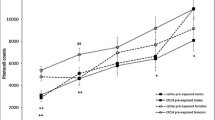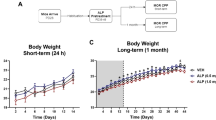Abstract
Rationale
Enhanced reinforcing effects of nicotine during adolescence appear to contribute to the rapid development of dependence in this age group. However, the contribution of nicotine withdrawal to dependence in adolescents is unclear.
Objective
We compared motivational and somatic signs of nicotine withdrawal in adolescent and adult rats.
Materials and methods
In experiment 1, motivational signs of nicotine withdrawal were compared using intracranial self-stimulation procedures after administration of mecamylamine (1.5 mg/kg, i.p.) in adolescent and adult rats made dependent on nicotine (9 mg/kg/day). Somatic signs of withdrawal were compared in two experiments using various doses of nicotine (adolescent doses: 0, 1.6, 3.2, 4.7 mg/kg/day; adult doses: 0, 1, 2.1, 3.2 mg/kg/day, expressed as nicotine base) to produce dependence and one dose of mecamylamine (1.5 mg/kg, i.p.) to precipitate withdrawal (experiment 2) and in a subsequent experiment, using various doses of mecamylamine (0, 0.75, 1.5, 3.0 mg/kg, i.p.) to precipitate withdrawal and a dose of nicotine (adolescent dose: 4.7 mg/kg/day; adult dose: 3.2 mg/kg/day) that produced equivalent nicotine blood levels in these age groups (experiment 3).
Results
Adolescents did not display the decreases in brain reward function observed in adults experiencing withdrawal, and displayed fewer somatic signs of nicotine withdrawal relative to adults regardless of the dosing procedure used.
Conclusion
The negative effects of nicotine withdrawal are lower during adolescence relative to later periods of development. Both the enhanced rewarding effects and the diminished nicotine withdrawal likely contribute to the rapid development of nicotine use during adolescence.


Similar content being viewed by others
References
Abreu-Villaca Y, Seidler FJ, Slotkin TA (2003) Impact of adolescent nicotine exposure on adenylyl cyclase-mediated cell signaling: enzyme induction, neurotransmitter-specific effects, regional selectivities, and the role of withdrawal. Brain Res 988:164–172
Adriani W, Macri S, Pacifici R, Laviola G (2002) Peculiar vulnerability to nicotine oral self-administration in mice during early adolescence. Neuropsychopharmacology 27:212–224
Adriani W, Caprioli A, Granstrem O, Carli M, Laviola G (2003a) The spontaneously hypertensive-rat as an animal model of ADHD: evidence for impulsive and non-impulsive subpopulations. Neurosci Biobehav Rev 27:639–651
Adriani W, Spijker S, Deroche-Gamonet V, Laviola G, Le Moal M, Smit AB, Piazza PV (2003b) Evidence for enhanced neurobehavioral vulnerability to nicotine during periadolescence in rats. J Neurosci 23:4712–4716
Belluzzi JD, Lee AG, Oliff HS, Leslie FM (2004) Age-dependent effects of nicotine on locomotor activity and conditioned place preference in rats. Psychopharmacology 174:389–395
Breslau N, Peterson EL (1996) Smoking cessation in young adults: age at initiation of cigarette smoking and other suspected influences. Am J Public Health 86:214–220
Bruijnzeel AW, Markou A (2004) Adaptations in cholinergic transmission in the ventral tegmental area associated with the affective signs of nicotine withdrawal in rats. Neuropharmacology 47:572–579
Chambers RA, Taylor JR, Potenza MN (2003) Developmental neurocircuitry of motivation in adolescence: a critical period of addiction vulnerability. Am J Psychiatry 160:1041–1052
de Graaf-Peters VB, Hadders-Algra M (2006) Ontogeny of the human central nervous system: what is happening when? Early Hum Dev (in press)
DiChiara G (2000) Role of dopamine in the behavioural actions of nicotine related to addiction. Eur J Pharmacol 393:295–314
DiFranza JR, Wellman RJ (2003) Preventing cancer by controlling youth tobacco use. Semin Oncol Nurs 19:261–267
Faraday MM, Elliott BM, Philips JM, Grunberg NE (2003) Adolescent and adult male rats differ in sensitivity to nicotine’s activity effects. Pharmacol Biochem Behav 74:917–931
Gåddnås H, Piepponen TP, Ahtee L (2002) Mecamylamine decreases accumbal dopamine output in mice treated chronically with nicotine. Neurosci Lett 330:219–222
Hildebrand BE, Svensson TH (2000) Intraaccumbal mecamylamine infusion does not affect dopamine output in the nucleus accumbens of chronically nicotine-treated rats. J Neural Transm 107:861–872
Hildebrand BE, Nomikos GG, Hertel P, Schilstrom B, Svensson TH (1998) Reduced dopamine output in the nucleus accumbens but not in the medial prefrontal cortex in rats displaying a mecamylamine-precipitated nicotine withdrawal syndrome. Brain Res 779:214–225
Herlenius E, Lagercrantz H (2004) Development of neurotransmitter systems during critical periods. Exp Neurol 190(Suppl 1):S8–21
Hurt RD, Croghan GA, Beede SD, Wolter TD, Croghan IT, Patten CA (2000) Nicotine patch therapy in 101 adolescent smokers: efficacy, withdrawal symptom relief, and carbon monoxide and plasma cotinine levels. Arch Pediatr Adolesc Med 154:31–37
Koob GF, Le Moal M (2005) Plasticity of reward neurocircuitry and the ‘dark side’ of drug addiction. Nat Neurosci 8:1442–1444
Kornetsky C, Esposito RU (1979) Euphorigenic drugs: effects on the reward pathways of the brain. Fed Proc 38:2473–2476
Kenny PJ, Markou A (2001) Neurobiology of the nicotine withdrawal syndrome. Pharmacol Biochem Behav 70:531–549
Kenny PJ, Markou A (2005) Conditioned nicotine withdrawal profoundly decreases the activity of brain reward systems. J Neurosci 25:6208–62012
Levin ED, Rezvani AH, Montoya D, Rose JE, Swartzwelder HS (2003) Adolescent-onset nicotine self-administration modeled in female rats. Psychopharmacology 169:141–149
Malin DH (2001) Nicotine dependence: studies with a laboratory model. Pharmacol Biochem Behav 70:551–559
Malin DH, Lake JR, Carter VA, Cunningham JS, Hebert KM, Conrad DL, Wilson OB (1994) The nicotinic antagonist mecamylamine precipitates nicotine abstinence syndrome in the rat. Psychopharmacology 115:180–184
McDonald JW, Johnston MV (1990) Physiological and pathophysiological roles of excitatory amino acids during central nervous system development. Brain Res Brain Res Rev 15:41–70
O’Dell LE, Bruijnzeel AW, Ghozland S, Markou A, Koob GF (2004) Nicotine withdrawal in adolescent and adult rats. Ann N Y Acad Sci 1021:167–174
Panagis G, Kastellakis A, Spyraki C, Nomikos G (2000) Effects of methyllycaconitine (MLA), an alpha 7 nicotinic receptor antagonist, on nicotine- and cocaine-induced potentiation of brain stimulation reward. Psychopharmacology 149:388–396
Rada P, Jensen K, Hoebel BG (2001) Effects of nicotine and mecamylamine-induced withdrawal on extracellular dopamine and acetylcholine in the rat nucleus accumbens. Psychopharmacology 157:105–110
Rahman S, Zhang J, Engleman EA, Corrigall WA (2004) Neuroadaptive changes in the mesoaccumbens dopamine system after chronic nicotine self-administration: a microdialysis study. Neurosci 129:415–424
Rose JE (1996) Nicotine addiction and treatment. Annu Rev Med 47:493–507
Skjei KL, Markou A (2003) Effects of repeated withdrawal episodes, nicotine dose, and duration of nicotine exposure on the severity and duration of nicotine withdrawal in rats. Psychopharmacology 168:280–292
Slotkin TA (2002) Nicotine and the adolescent brain: insights from an animal model. Neurotoxicol Teratol 24:369–384
Smith TA, House RF Jr, Croghan IT, Gauvin TR, Colligan RC, Offord KP, Gomez-Dahl LC, Hurt RD (1996) Nicotine patch therapy in adolescent smokers. Pediatrics 98:659–667
Sofuoglu M, Kosten TR (2004) Pharmacologic management of relapse prevention in addictive disorders. Psychiatr Clin North Am 27:627–648
Spear LP (2000) The adolescent brain and age-related behavioral manifestations. Neurosci Biobehav Rev 24:417–463
Suzuki T, Ise Y, Tsuda M, Maeda J, Misawa M (1996) Mecamylamine-precipitated nicotine-withdrawal aversion in rats. Eur J Pharmacol 314:281–284
Taioli E, Wynder EL (1991) Effect of the age at which smoking begins on frequency of smoking in adulthood. N Engl J Med 325:968–969
Torrella TA, Badanich KA, Philpot RM, Kirstein CL, Wecker L (2004) Developmental differences in nicotine place conditioning. Ann N Y Acad Sci 1021:399–403
Trauth JA, Seidler FJ, Slotkin TA (2000) An animal model of adolescent nicotine exposure: effects on gene expression and macromolecular constituents in rat brain regions. Brain Res 867:29–39
Watkins SS, Stinus L, Koob GF, Markou A (2000) Neural mechanisms underlying nicotine addiction: acute positive reinforcement and withdrawal. J Phamacol Exp Ther 292:1053–1064
Wilmouth CE, Spear LP (2004) Adolescent and adult rats’ aversion to flavors previously paired with nicotine. Ann NY Acad Sci 1021:462–464
Vann RE, Balster RL, Beardsley PM (2005) Dose, duration, and pattern of nicotine administration as determinants of behavioral dependence in rats. Psychopharmacology 7:1–12
Vastola BJ, Douglas LA, Varlinskaya EI, Spear LP (2002) Nicotine-induced conditioned place preference in adolescent and adult rats. Physiol Behav 77:107–114
Yeom M, Shim I, Lee HJ, Hahm DH (2005) Proteomic analysis of nicotine-associated protein expression in the striatum of repeated nicotine-treated rats. Biochem Biophys Res Commun 326:321–328
Acknowledgements
This research was supported by the Robert Wood Johnson Foundation Tobacco Etiology Research Network, the California Tobacco-Related Disease Research Program (11FT-0112 to AWB, 12RT-0099 to GFK, and 12RT-0231 to AM), and the National Institute on Drug Abuse (DA11946 to AM). The authors thank Mr. Michael Arrends for his excellent editorial assistance and Yanabel Grant for her technical assistance. This is publication number 16665-NP from The Scripps Research Institute.
Author information
Authors and Affiliations
Corresponding author
Rights and permissions
About this article
Cite this article
O’Dell, L.E., Bruijnzeel, A.W., Smith, R.T. et al. Diminished nicotine withdrawal in adolescent rats: implications for vulnerability to addiction. Psychopharmacology 186, 612–619 (2006). https://doi.org/10.1007/s00213-006-0383-6
Received:
Accepted:
Published:
Issue Date:
DOI: https://doi.org/10.1007/s00213-006-0383-6




